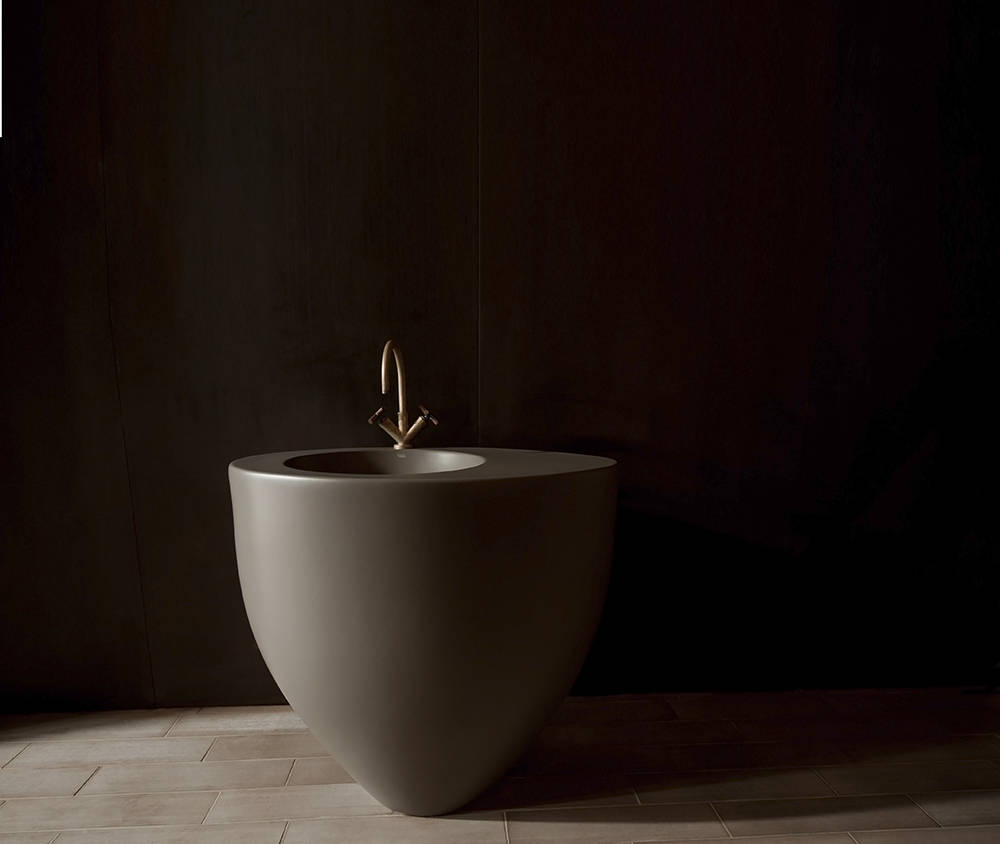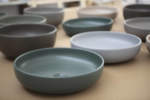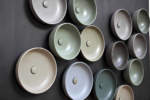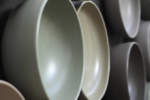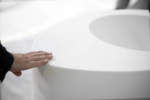The free standing ceramic washbasin, Le Giare collection, special colored for the Antinori Winery. Designed by Claudio Silvestrin. Photo by Valentina Muscedra.
Marco Casamonti: At a time when ceramic for the bath is largely influenced by the minimalism of white, what prompted Cielo to break away from this custom?
Alessio Coramusi: I have to say that the use of color in the bath setting, particularly in the ceramic sanitary units, was particularly fashionable in the Sixties and Eighties of the past century, with sanitary units in black, red, pink and other bright colors combined with a path characterized by the use of tiles and wall covering in strongly contrasting shades. This echoes in some respects the image of the Pop environments of those years, characterized by large, hypercolorful decorations.
In the Nineties, the fashion in sanitary units changed and there was a return to the use of white only, because the bathroom ceased to be a place of strong decoration and became a room like any other, focusing on rigor and sobriety. That has continued up to the present. Our idea was to bring color back into the bath environment, but not the bright vivid colors of the Seventies, not the Pop image of a hyperdecorated space, but pastel colors, capable of giving the bathroom that idea of naturalness, of sustainability, of eco-compatibility that characterizes so many of the rooms in the home. So we undertook a research project that was particularly attentive to the use of color for the ceramics, seeking the most natural look for the elements, for the furnishings and architecture of the home, so that they is a less artificial atmosphere in our living spaces. Basically, even the color white, as used in the enamels for sanitary units, is an artificial color: natural clays are not white. We tried to interpret the desire to return to the use of natural elements in the home. The colors of the earth, of wood, of bone, the colors of nature. This return to color, therefore, is completely different and absolutely alternative to the loud, psychedelic colors of the Eighties. It is a return to color that means rigor, sobriety, but also harmony with the images and a way of living in nature.
M.C.: How and when did you undertake this new research process? The territorial identity of Civita Castellana, where the company is located, is strongly characterized by the presence of nature, from tuff to clays, to the vegetable elements. Did that influence the new color and texture choices of Cielo?
A.C.: The color research undertaken by Cielo arises above all from the desire of the interior designers and architects. In particular you, as our art-director, while you were designing the great cellar for the Marchesi Antinori winery, a sort of homage to nature, asked us to do some research on enamels that would represent the colors of nature, the colors of the clay. We started from the needs of a specific project, therefore, trying to find, with you, the tints of the years; it was a labor whose goal was to find a series of enamel shades that could be offered on the market.
But the experience of the Antinori Cellar also taught us that every architect can, on the basis of certain numbers, also choose his own color, which shows that the sanitary unit is no longer a design object furnished as unchangeable, but an element that can, in turn, be designed through specific studies. Naturally, you shouldn’t think the study of color in ceramic is an easy process, or one that can be taken for granted. Take for example the great ceramic artists from the Renaissance, like Luca Della Robbia, to the 20th century, with Giò Ponti: they all set out to find specific color effects through research. When colors are fired, they reach temperatures as high as 1200 degrees, and this changes them both physically and chemically. To obtain a color, therefore, we have to produce another, considering the entire production process. Color research is very difficult and requires trained workers. In our case, to select the 12 colors we are now offering on the market, we needed over 12 months of tests, with you and our staff, to obtain the colors of stone, concrete, rocks, trees, leaves, all with very great effort. We think, however, that our efforts will be rewarded by the uniqueness of our offering on the market that, at the present time, only Cielo is able to make, and which brings the ceramic art back to the bath environment.
In this aspect, the territory is close to us, because Civita Castellana is characterized by a very great tradition that, in particular in our company, is maintained and protected as a resource for a labor of love, processing ceramic.
M.C.: Color also means new texture, new tactile sensations for sanitary units or the sink. Does that mean the new shades of Cielo also correspond to a new tactile sensation of the design object?
A.C.: Certainly, Cielo was the first company in its sector that, in addition to working on the volumes and shapes, also worked on the surface texture. In particular, all the colors offered by Cielo, just because they want to give the product an idea of absolute naturalness, are associated with materials that are not glossy, but produced with a soft finish that is particularly pleasing to the touch. Our objects are velvety and, to the touch, evoke stone, wood and plants. There is a softness in them that belongs to a type of search for nature that is not limited, obviously, to color alone, but that affects the tactile sensation as well. We can therefore say that, in addition to the color, the tactile experience is one that characterizes Cielo’s new surfaces.
I wouldn’t talk simply about color, but rather about a project that works on perception and the sensations that are both tactile and chromatic. Now we are also experimenting, and this is something new for us, with an olfactory experience.
M.C.: Cielo is working in the view of a greater customization of the bath environment. Does the possibility that Cielo gives its clients to choose their color and their tactile effect also mean that the end customer has the power to plan a custom environment?
A.C.: Right now Cielo isn’t looking only at the end customer, but with particular attention, also at the interior designer. The bath must be an environment that can and should be designed. Cielo wants to furnish designers with the working tools they need to build spaces and environments, in line with peoples feelings and desires. This is the interior designer’s task, but also that of the company: its mission is to supply them with the tools they need to achieve this result.
Alessio Coramusi, CEO Ceramica Cielo.
Cielo is an important player in the field of Italian ceramic art for the quality of design and technology. The basis of the uniqueness of Cielo design product lies in the entrepreneurial capacity to conciliate the industrial product quality with the desire not to lose the done by hand tradition. Each individual piece out of Cielo‘s ovens is processed, shaped and polished by the expert hands of women and men, true craftsmen, who thereby transform a serial product in a real piece of design, unique and precious; handmade products in Italy into which technological innovation, recovery of the manufacturing tradition and artistic expression merge.


